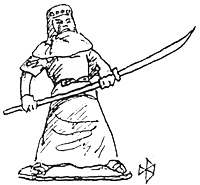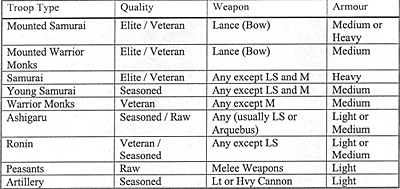 These rules are intended for playing large-scale samurai battles using 15mm wargames figures. They should work well with other scales since they use a fixed stand size. It is my intention to support these rules through a web site currently in development. Thanks are due to Colin Bremner for his advice and critique during the testing of these rules.
These rules are intended for playing large-scale samurai battles using 15mm wargames figures. They should work well with other scales since they use a fixed stand size. It is my intention to support these rules through a web site currently in development. Thanks are due to Colin Bremner for his advice and critique during the testing of these rules.
The rules cover the period known as The Age of the Country at War or Sengoku-Jidai. This was a period when samurai armies became much more organised, the importance of ashigaru troops was recognised and the increasing use of firearms altered samurai warfare forever. It was also an age that produced some great commanders such as Oda Nobunaga, Toyotomo Hideyoshi and Tokugawa Ieyasu to name but a few. And, in a period of continual warfare, there were hundreds of battles, some of them epic encounters like Nagashino, Sekigahara and Kawanakajima. It is my hope that Daimyo will capture some of the excitement of this colourful and unique period of history.
Scales
Ground scale: 1cm = 10 metres.
Figure Scale: 1 stand = 150-300 men.
For campaign purposes, a complete turn can be considered to be about 20 minutes.
All distances in the rules are in centimetres. All dice are of the normal six-sided variety, therefore the term “2d6” means roll two six-sided dice to yield a total. The only record keeping is for leader command ratings.
Contents
1. Troop classifications / Organisation
2. Sequence of play
3. Movement
4. Disorder
5. Morale
6. Firing
7. Melee
8. Artillery
9. Weather
10. Winning and Losing
1. Troop classifications / Organisation
A stand of figures can be of any suitable width/depth and have any number of figures. The only requirement is that all stands be of the same width. Only leaders can be based individually. All figures on a stand must be of the same basic troop type. Ideally, most of the figures should have a sashimono (back banner) to aid in identifying their clan. At least one officer, standard bearer and musician figure is recommended per unit to enhance visual appearance. My stands are 40mm wide and have three figures each and base depths are 15mm for infantry and 30mm for cavalry. The table below specifies the available troop classifications.

Troop Type is the basic classification of a figure. Mounted Samurai and Mounted Warrior Monks are collectively referred to as Cavalry. All other types are collectively referred to as Infantry. References to Samurai include Mounted Samurai and Young Samurai unless specifically stated. References to Warrior Monks include Mounted Warrior Monks unless specifically stated. Rules for Artillery are listed under optional rules since cannon was rarely used on the battlefield.
Quality can be thought of as a combination of training, experience and morale. Levels from highest to lowest are Elite, Veteran, Seasoned and Raw. Elite would normally, but not exclusively, be reserved for the General’s hatamoto unit, see Generals section below.
Weapon is the main weapon used by the unit. All cavalry carry Lance (mochi-yari) and have the option to carry a Bow (yumi) in addition to the lance. For infantry, these can be Improvised Melee Weapons (M), Long-shafted Spear (LS), Pole Arm, Bow or Arquebus.
Improvised Melee Weapons include inferior quality swords, tetsubo (staff) and even farm implements used by peasants. The Long-shafted Spear (nagae-yari) can be up to 18 feet long and is the preferred weapon of non-missile armed ashigaru. Pole Arms include the majority of weapons used in close combat such as the yari (spear), naginata (glaive) and also the no-dachi (long two-handed sword). Bow (yumi) and Arquebus (teppo) armed troops can fire at range during the firing phase or, in some circumstances, when being charged. Missile armed ashigaru are considered to carry improvised melee weapons for close combat.
Armour rating reflects the amount of protection afforded by the armour and also affects the movement rate of the wearer. Armour classes are Heavy, Medium and Light.
Units and Clans
Stands are organised into units. A unit must begin the game with 2 to 8 stands.
An army is made up from a number of clans. Each clan can have from 1 to 6 units. I like to have lots of clans to enhance the visual effect of many different banners! My cavalry consist of single unit clans, and infantry clans have between 2 and 5 units (including a mix of samurai and ashigaru). These clans can have an archer, arquebusier or ronin unit added. With the exception of an Ikko-Ikki army, I really only see peasants being present if defending their village, or to the rear of the army with the baggage, not fighting in open battle (unless dictated by scenario or campaign). A typical army will have about 5-8 clans depending on clan makeup and size of battle. Each clan must have a daimyo represented by an individual figure, mounted or on foot as appropriate (see below). In the rules, the term “clan” is also used for a contingent of warrior monks.
Leaders
There are two types of leaders, Generals and Daimyos. Each army must be commanded by a General and each clan will be commanded by a Daimyo. These terms are used for convenience in the rules as some commanders would not necessarily be a daimyo, such as an Ikko-ikki leader, and the General himself could be a powerful daimyo.
Generals
Generals during this period tended to command from their suitably positioned headquarters enclosed by maku screens with communications being conducted through an efficient messenger system. Each army should have one General figure representing the army commander himself and his personal retainers. The General could be a daimyo, a monk or some other influential personage. He can be based as an individual, possibly seated, or on a cavalry size stand and include the general figure together with some members of his entourage such as standard bearers for aesthetic appearance. Whither based as a single figure or with other figures, the General is treated as an individual and does not participate directly in combat. Each General is given a Command Rating from 2 (worst) to 4 (best) that is used to determine which army has the initiative each turn. This rating may be decided by scenario/campaign, but for one-off games roll 1d6 on the Commander Rating Table before the game begins.
The General may be seated or mobile.
A seated General would be more common in this period but there were exceptions such as Tokugawa Ieyasu during his early career. The seated General begins the game in his headquarters and would normally remain there throughout the battle. Headquarters should measure at least 40mm x 30mm. When activated, the General may mount up and abandon his headquarters to become mobile. Once abandoned, the headquarters is permanently removed from the table for the rest of the game and the General must then remain mobile. The advantage of being seated is that he gains an initiative bonus (see Sequence of Play below).
A mobile General does not have a headquarters and may not set one up during the game. There are no restrictions on the initial deployment of a mobile General. The mobile General has the advantage of being able to join units and play a more active role in the battle but at the expense of possibly surrendering the initiative. Rules regarding the movement of Generals refer only to mobile Generals.
A small hatamoto (bodyguard) unit of 2 to 4 stands may accompany the General. This unit must be on foot for a seated General and mounted for a mobile one. Whether mounted or on foot, they must begin the game deployed within 20cm of the General and may be attached to the headquarters or a mobile General. They must remain within 20cm of the General and may only move beyond this distance as a result of combat or morale. They may willingly charge an enemy unit beyond the 20cm command range but should attempt to return to their lord as soon as possible. Should a seated General choose to abandon his headquarters, the hatamoto have the option of becoming mounted provided they are in contact with the headquarters, have no more than 2 stands and are not engaged in combat. Simply replace the infantry unit with mounted figures. As mounting up takes the full turn, they may not make any voluntary movement until the following turn. Hatamoto are activated with the General.
| Commander Rating | Die Roll | |||||
|---|---|---|---|---|---|---|
| 1 | 2 | 3 | 4 | 5 | 6 | |
| General | 2 | 3 | 3 | 3 | 3 | 4 |
| Daimyo | 1 | 1 | 2 | 2 | 2 | 3 |
Daimyos
Daimyos should be based as an individual figure, either mounted or on foot as appropriate. Daimyos are given a command rating in the range 1 (worst) to 3 (best) to reflect their overall ability and have a command range radius of 15cm whether attached to a unit or not. The command rating will be used in morale tests and also in obedience tests for units out of their command range. Attached commanders also impart a combat bonus in melee. As with generals, these ratings should be decided before the game begins using the same Commander Rating Table. As an option, roll for ratings when they are first required. In reality though, the ability of samurai commanders would be well known, even to their enemies – they weren’t shy when it came to advertising their prowess!
Daimyo Samurai Wargames Rules 1550-1615
Back to Table of Contents -- Lone Warrior # 144
Back to Lone Warrior List of Issues
Back to MagWeb Magazine List
© Copyright 2003 by Solo Wargamers Association.
This article appears in MagWeb (Magazine Web) on the Internet World Wide Web.
Other articles from military history and related magazines are available at http://www.magweb.com
